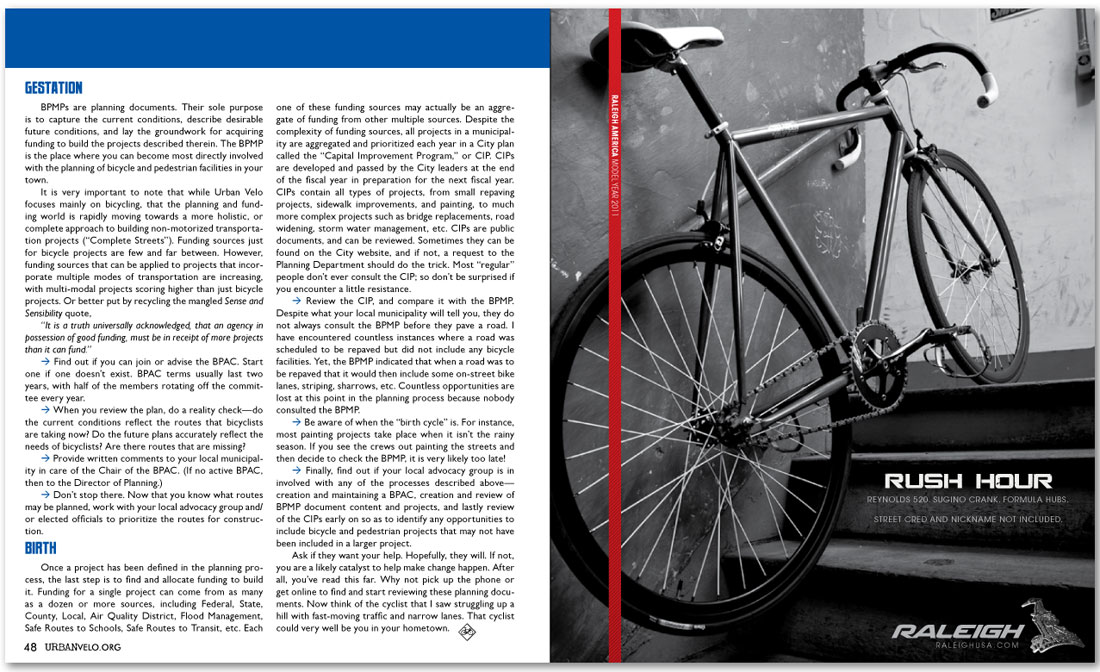


Gestation
BPMPs are planning documents. Their sole purpose is to capture the current conditions, describe desirable future conditions, and lay the groundwork for acquiring funding to build the projects described therein. The BPMP is the place where you can become most directly involved with the planning of bicycle and pedestrian facilities in your town.
It is very important to note that while Urban Velo focuses mainly on bicycling, that the planning and funding world is rapidly moving towards a more holistic, or complete approach to building non-motorized transportation projects (“Complete Streets”). Funding sources just for bicycle projects are few and far between. However, funding sources that can be applied to projects that incorporate multiple modes of transportation are increasing, with multi-modal projects scoring higher than just bicycle projects. Or better put by recycling the mangled Sense and Sensibility quote,
“It is a truth universally acknowledged, that an agency in possession of good funding, must be in receipt of more projects than it can fund.”
• Find out if you can join or advise the BPAC. Start one if one doesn’t exist. BPAC terms usually last two years, with half of the members rotating off the committee every year.
• When you review the plan, do a reality check—do the current conditions reflect the routes that bicyclists are taking now? Do the future plans accurately reflect the needs of bicyclists? Are there routes that are missing?
• Provide written comments to your local municipality in care of the Chair of the BPAC. (If no active BPAC, then to the Director of Planning.)
• Don’t stop there. Now that you know what routes may be planned, work with your local advocacy group and/or elected officials to prioritize the routes for construction.
Birth
Once a project has been defined in the planning process, the last step is to find and allocate funding to build it. Funding for a single project can come from as many as a dozen or more sources, including Federal, State, County, Local, Air Quality District, Flood Management, Safe Routes to Schools, Safe Routes to Transit, etc. Each one of these funding sources may actually be an aggregate of funding from other multiple sources. Despite the complexity of funding sources, all projects in a municipality are aggregated and prioritized each year in a City plan called the “Capital Improvement Program,” or CIP. CIPs are developed and passed by the City leaders at the end of the fiscal year in preparation for the next fiscal year. CIPs contain all types of projects, from small repaving projects, sidewalk improvements, and painting, to much more complex projects such as bridge replacements, road widening, storm water management, etc. CIPs are public documents, and can be reviewed. Sometimes they can be found on the City website, and if not, a request to the Planning Department should do the trick. Most “regular” people don’t ever consult the CIP; so don’t be surprised if you encounter a little resistance.
• Review the CIP, and compare it with the BPMP. Despite what your local municipality will tell you, they do not always consult the BPMP before they pave a road. I have encountered countless instances where a road was scheduled to be repaved but did not include any bicycle facilities. Yet, the BPMP indicated that when a road was to be repaved that it would then include some on-street bike lanes, striping, sharrows, etc. Countless opportunities are lost at this point in the planning process because nobody consulted the BPMP.
• Be aware of when the “birth cycle” is. For instance, most painting projects take place when it isn’t the rainy season. If you see the crews out painting the streets and then decide to check the BPMP, it is very likely too late!
• Finally, find out if your local advocacy group is in involved with any of the processes described above—creation and maintaining a BPAC, creation and review of BPMP document content and projects, and lastly review of the CIPs early on so as to identify any opportunities to include bicycle and pedestrian projects that may not have been included in a larger project.
Ask if they want your help. Hopefully, they will. If not, you are a likely catalyst to help make change happen. After all, you’ve read this far. Why not pick up the phone or get online to find and start reviewing these planning documents. Now think of the cyclist that I saw struggling up a hill with fast-moving traffic and narrow lanes. That cyclist could very well be you in your hometown.
Raleigh